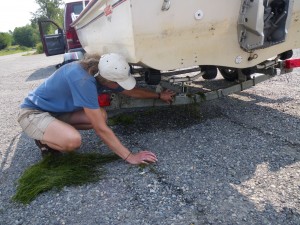“Clean, drain, dry” is the mantra of modern boating etiquette. It’s also what we should do with all our equipment whenever we travel from one lake, river or stream to another, even if it’s just our wading boots that have gotten wet. Why? Because invasive species are excellent hitchhikers.
Harmful hitchhikers
The most infamous culprits are zebra and quagga mussels. These small freshwater mussels have a free-swimming young stage (called a veliger) that can be found in open water, as well as the more well-known adults that attach to any more-or-less solid surface. These mussels reproduce at a prodigious rate (up to a million eggs per year per female) and grow on top of each other. In one Michigan power plant, 700,000 zebra mussels were found per square meter. At this density, they cause many problems as they fill pipes and clog screens at dams and water delivery structures. Each mussel can filter around a quart of water a day, so when their numbers skyrocket, they filter out a huge proportion of the algae that forms the base of much of the aquatic food web. The waterbodies they infest may clear up, but only at great cost to native plants and animals.
Luckily, these mussels aren’t known to be present in the Northwest — yet. If and when they do arrive, they would likely inflict tens to hundreds of millions of dollars worth of damage each year on dams, water delivery systems, and fish and wildlife habitat in the Columbia River system and beyond. Because they attach to everything solid, they are easily carried to new waterbodies by boats. Last year, inspection stations in Idaho found 36 mussel-infested boats heading to Northwest waters, and several have already been found this year as well.
Mussels aren’t the only scary thing hitching a ride with unwitting people. The New Zealand mudsnail is another, though it most famously rides on wading boots rather than boat trailers. The snails live on the bottom of streams or lakes, and crawl onto boots as people fish or collect scientific data. The impacts of the mudsnail are not well-studied yet, but they can reproduce very quickly – and, in fact, clone themselves so that only one is needed to start a new population. They can build to densities of more than 500,000 per square meter, and can pass through fish undigested. Mudsnails impact food webs by consuming the algae that would normally be eaten by aquatic insects that feed the fish. These snails are known to be present in the Snake River system, the lower Columbia River, Capitol Lake in Olympia and Thornton Creek in Seattle. However, since they are only about ¼ inch long, they may well be lurking undetected in other locations.
Another hitchhiker, one that commonly rides on felt-soled wading boots, is the algae didymo. This is a type of algae called a diatom, with a long stalk. It is native to Washington but its populations can occasionally explode in low-nutrient streams, covering the whole streambed. Didymo has not been problematic in Washington to date, but it does cause problems in other parts of the country and the world; many states have banned felt-soled wading boots in an attempt to stop its spread.
Eurasian watermilfoil is also commonly spread by boating activities. It has long, flexible stems, and easily grows from fragments that remain damp — and thus viable — while riding between waterbodies. This accounts for its current wide distribution in Washington. Other invasive aquatic plants also spread easily when seeds or fragments are accidentally carried from waterbody to waterbody. Diseases that harm fish and amphibian species can also be carried in mud or other debris that may cling to boats, trailers, boots and other gear.
Stop the spread with “clean, drain, dry”
So, what do we do? Clean your boats, trailers, boots and anything else that gets wet. Check seams and hard-to-reach places. The best location for this is a commercial car wash – high-pressure water will help blast off anything that might be clinging to gear, and the water should drain to a sanitary sewer or septic system. If you cannot get to a car wash, use a brush and clean water to scrub your boat and gear thoroughly. Do this scrubbing and cleaning before leaving the waterbody, or do it where the washwater draining off your gear will not contaminate another creek or lake. If you have been boating in a part of the country with zebra or quagga mussels, you must have your watercraft cleaned with hot water to make sure that all mussels are not only off, but dead.
Once you have cleaned everything, make sure to drain all water from any nook or cranny that may store it. Leave drain plugs out of boats so the bilges can dry. Lastly, dry all gear thoroughly. In the summer in much of Eastern Washington, this isn’t much of a problem, but during rainy weather, be sure to store gear so that all parts dry completely between uses.
Do your part to stop invasive species from hitchhiking their way into Washington’s lakes and other waterbodies. Not only is it the right thing to do, it’s the law!










